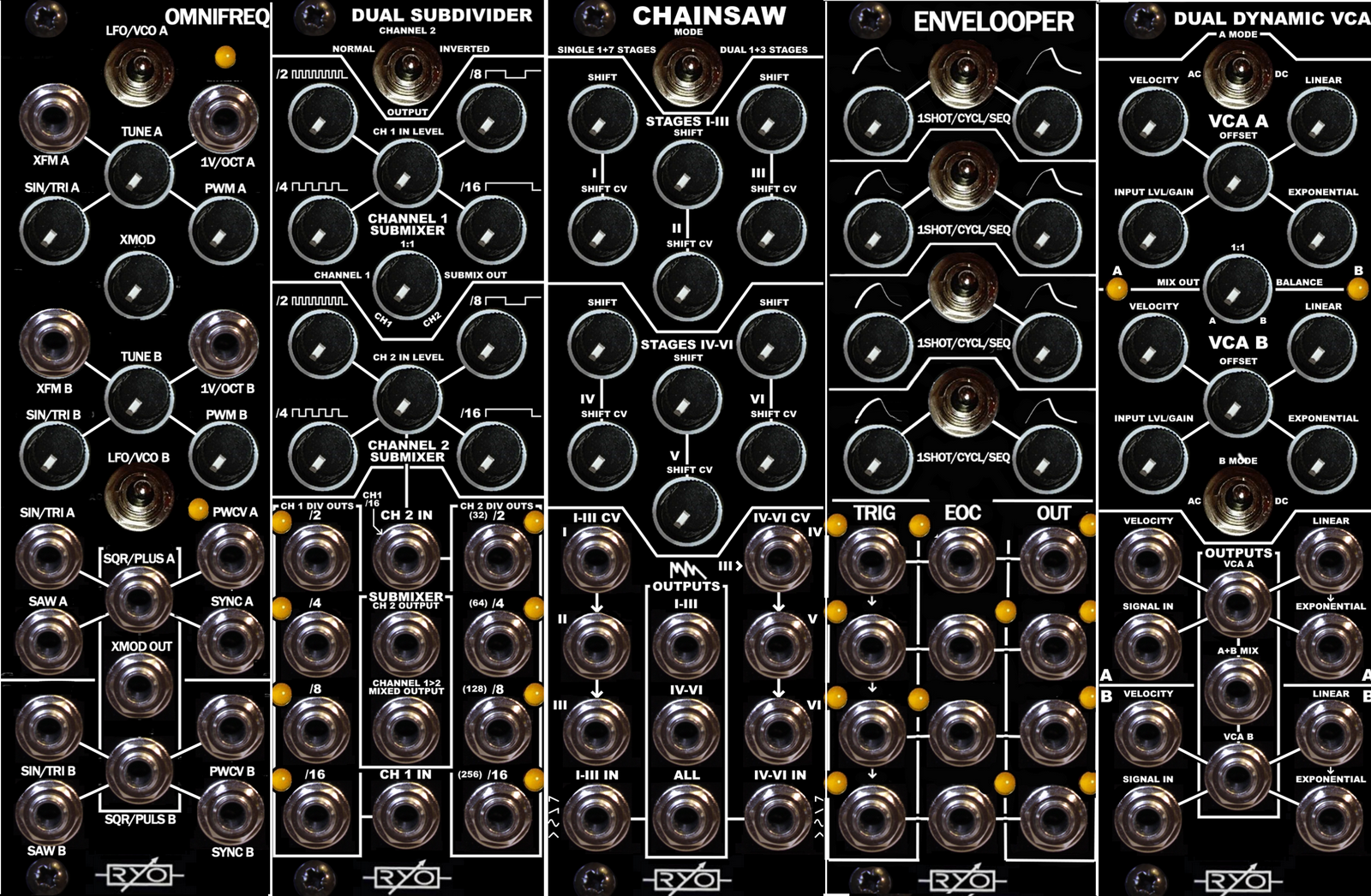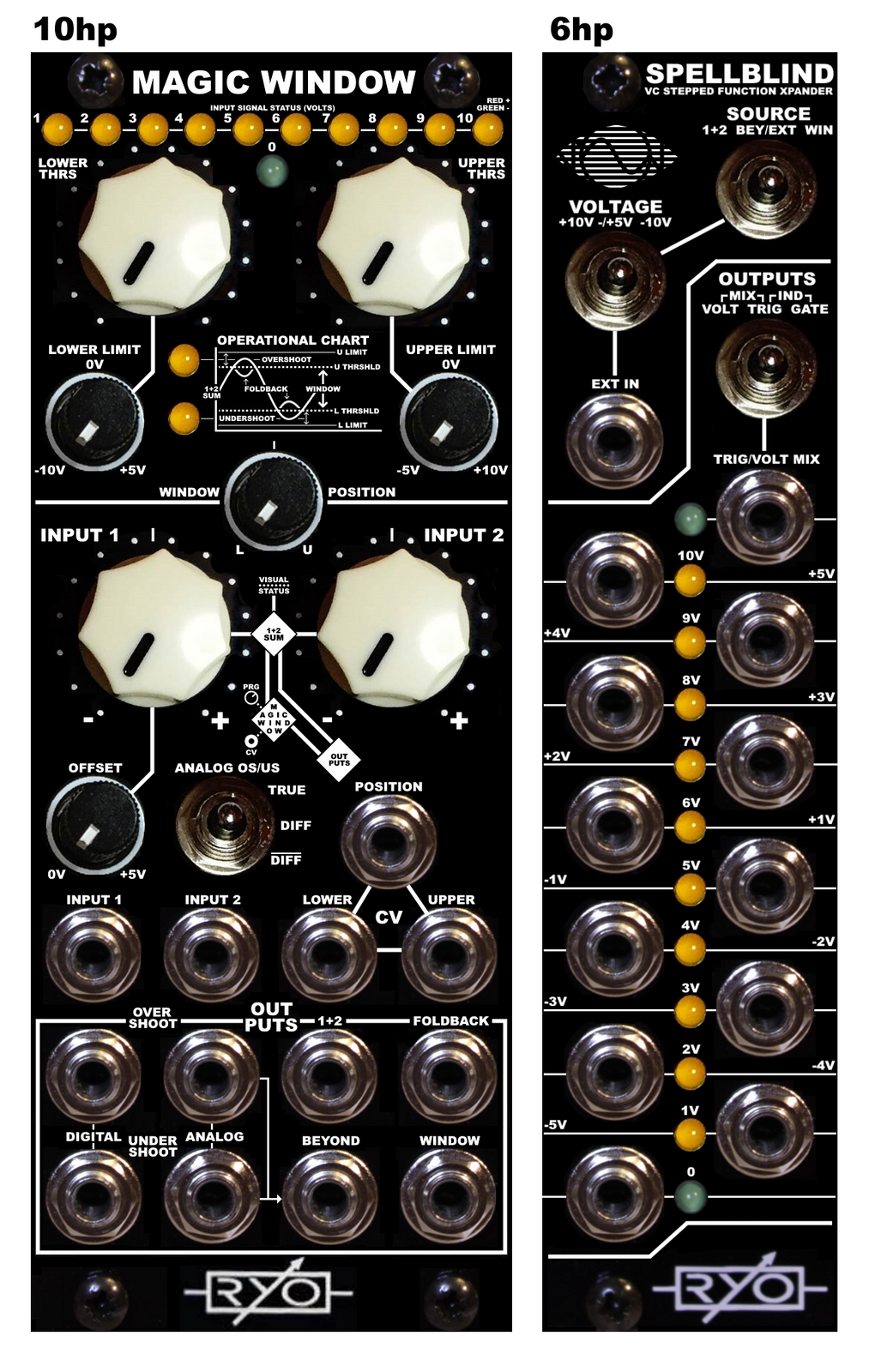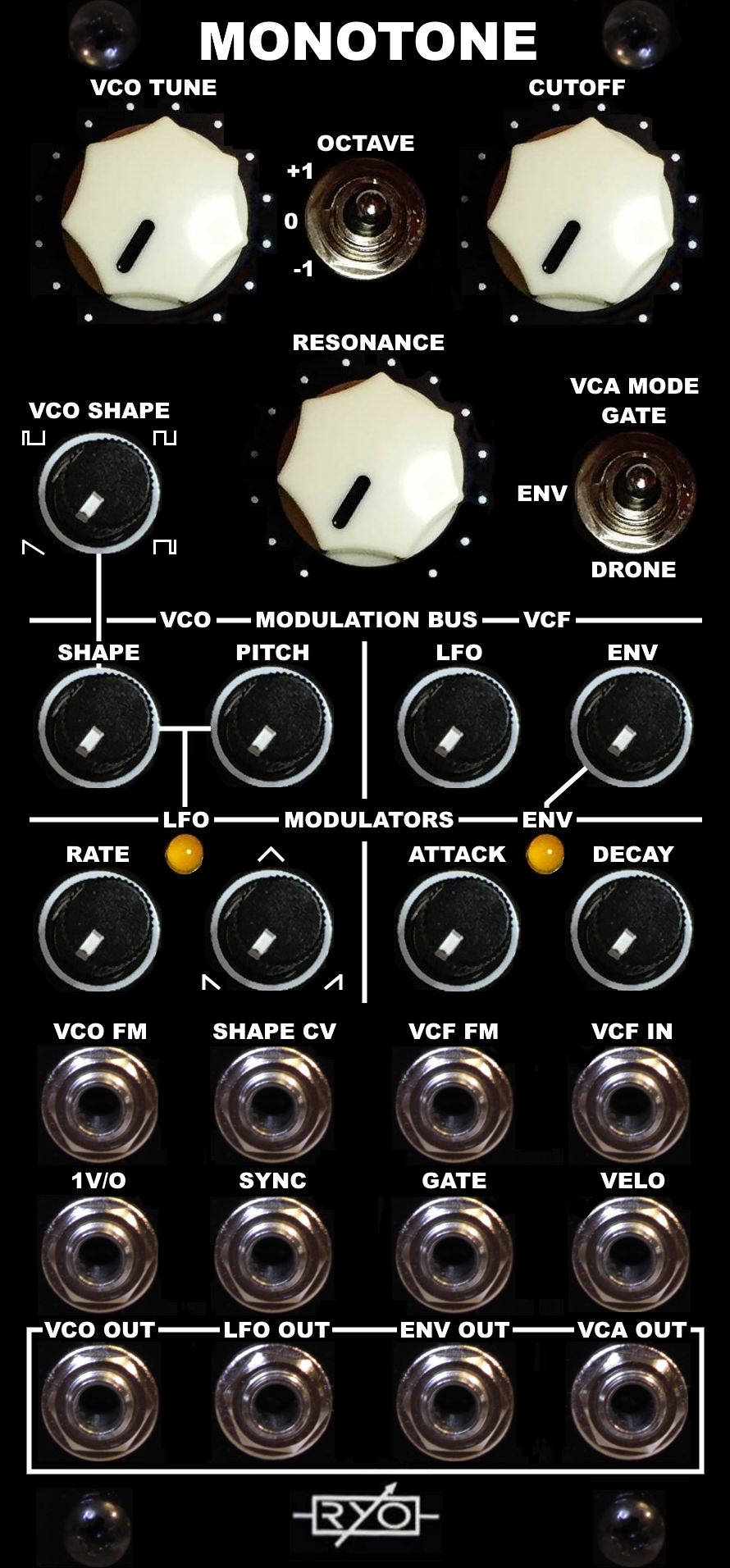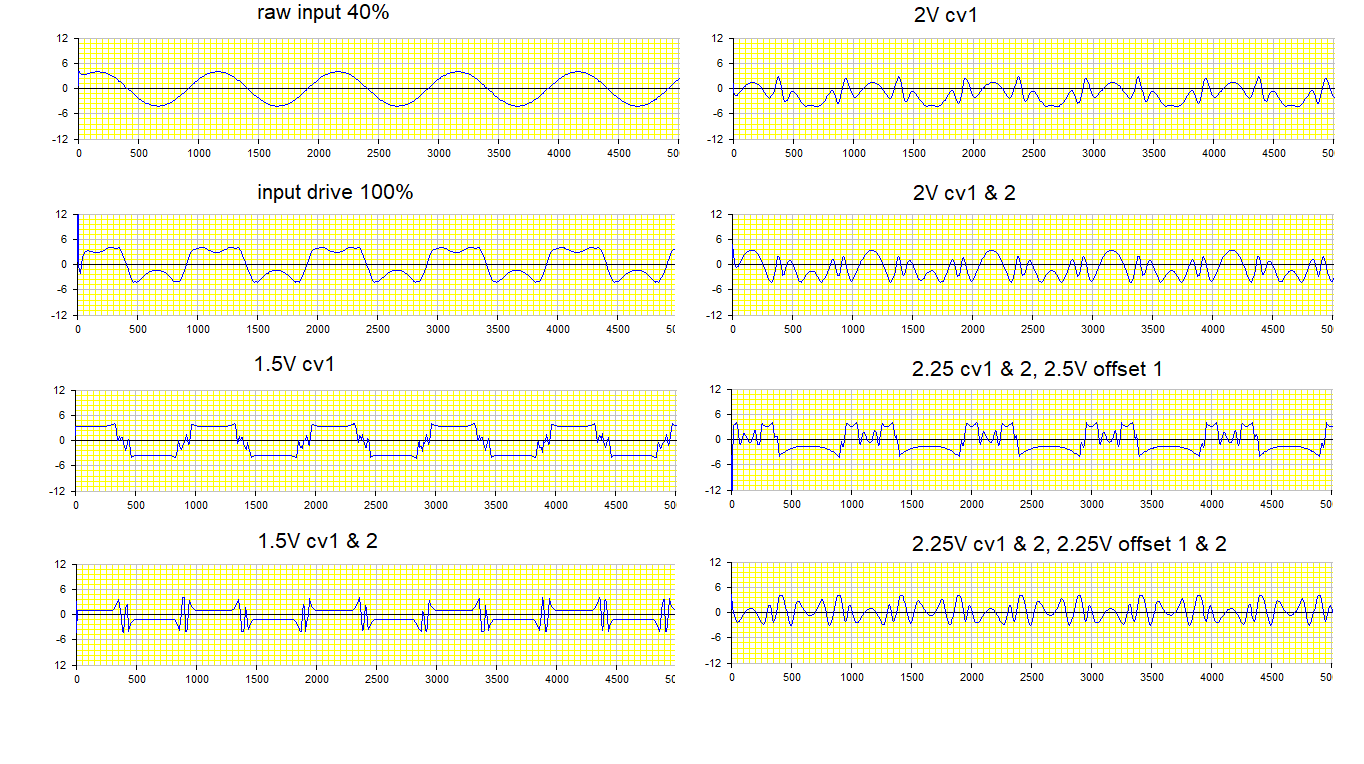These are some future modules that are currently in development!
The forthcoming Total Stimme complete voice range - everything needed to start a basic vco/vca/modulator and sound processing setup. Stimme is German for 'voice' and seemed like a nice name ofr the collection.


Magic Window is a dual input window comaparator with analogue and digital outputs derived from a number of key parts of the window features.
- it has cv, manual control and offset on ch 1 for upper and lower window limits;
- cv and manual control over window position;
- manual threshold controls and switchable logic modes for the threshold over/undershoot;
- both digital and analogue outs for overshoot crosssings
- LED display of input signal, overshoot and zero point centering;
- 1+2 output, foldback output, window output and in the fial schematric design the 'beyond' output has become a bidirectional switch triggered by the threshold crossings.
Spellbound is an expander for Magic Window that provides stepped fucntion outputs:
- it offers trig, gate or continuous voltage output and can processs extrernal input signals as well as producing signals internally.
- output voltage can be switched between +10, +/-5 and -10V.
- there's a very clear, visible led display to show output level in a nice visually graspable manner.
The RYO noise gate willll be one of only two noie gate module currently on the market nad is by far the most fully fatured dedicated gate dynmaics module out there:
- it has cv and manual control over threshold;
- cv and manual control over hold;
- cv control over key level;
- manual attack, release and key level controls;
- dual LED displays of output levels to allow use of both switchable peak/bar modes and fade/quick mode indicators simulateously to aid setting the controls just right for purpose;
- the makeup gain has a very large maximum so as to allow for both low input signal and any significant loss of signal during processing
- tehre is also input level control to avoid clipping the input with hot signals.
- meter led brightness can be adjust from the front via the small set-screws avoiding the need for taking the module out of the case to make alterations depending on light levels in the current environment - very useful for transferring between studio and live use.
- full specs to bw available when prototyping is complete.


The RYO Monotone is a purely conceptual VCO/VCA/FILTER combination module with built in EG and LFO:
- at core it would be a simple VCO with 1V/Oct, expo-FM, Sync and cv over continuous variable shape output from saw to pulse via tri, through square to pulse at the other extreme of PWM;
- A basic VCA to be controlled either by the internal EG, a direct gate signal or simply pass sound in a 'drone' mode;
- velocity input allows a second level of control over the vca for emphasis of note volume;
- The filter is a simple resonant low pass with ext input capabiility as well as to filter the internal VCO;
- The VCF has VC over freq and hence can be FM modulated in all the ways expected of a VC Filter;
- The LFO also has continuously variable shape from saw to tri to ramp;
- there is also an EG with individually controllable attack and decay timings;
- the amount of effect the LFO and EG have on the filter and VCA is controlle by two knobs in a mixe type setup..
- VCO, LFO, EG and VCA all have their own individual outs.
- full specs to bw available when prototyping is complete.
The RYO [waveform???] is a fairly classic wavefolder using a lockheart transistor configuration in a number of stages separated by VCAs to allow great control over level of folding and hence timbre.
- it has a big fat red knob to conrol the main manual folding level;
- attenuator and offset controls for both folding stages;
- there is full cv control over both the amplitude oof incoming signal and hence degree of foldign at each stage as well as vc over a bias that offsets the signal, altering folding shapes in a manner quite pleasing o the ear.
- the module can produce na immense variety of wavefolded output sounds from the simplest sine input right up to complex audio;
- it can also fold cv as well as audio rate wave forms, being both dc coupled and able to work at low frequencies
- not only does it offer a huge variety in foldeed waveshapes but all can be morphed between in continuous shape changiong via the plentiful cv conttrols.


this all means the most spectacular new timbres can be derived from even the simplest of inputs!
- to the right are some examples of the output wavforms achieved when feeding a 5Vpp audio rate sinewave into the wavefolder at various settings
- note these are but a small sample of some very basic tweaks and a much more complex, detailed and weird range of waves can be achieved, and importantly, dynamically - even at audio rate!
***PIC IS MISSING I/o - ONLY HAS O/I PAIRS - switches missing too!!!***
OOPS OOPS OOPS OOPS OOPS OOPS OOPS OOPS OOPS OOPS OOPS OOPS OOPS
The RYO DT Switch has been a very long time coming and has been htrough at least 5 diffferent iterations of internal circuitry, including an arduino based model, yet now its in its final form, fully analogue and as elegantly efficient and simle in both internal design and external design as can be ahcieved:
- the switch is the latest addition to the forthcoming line of analogue logic modules, and has a performance leaning to its design, being spacious/ergonomic and easy to use manually in a real time style.
- its' a dual bidirectional switch with manual push-button control for each channel as well as cv inputs for those switches.
- there are easy to follow LED indicators to show trig/gate prescence, and which outputs/inputs are active at a given time, colour coded for different sides to avoid confusion in a live environment.
- The nicely spaced push button switch controls for manual control over switching are sognificantly different coloured , agan to avoid confusion in live and high pressure situations.
- controls, i/Os and trig/gate sockets are arranged in to matching colums so it's even easier to keep track of which channnel is which.
- trig/gate sockets are equipped with schmitt triggers to alllow any signal crossing the 2.2V threshold voltage - sines, we4ird wavefolded squiggles - absolutely anything you can come up with!
- I/O and O/I sockets can pass any eurorack audio or cv signal and will act both in switchable latching or momentary fashion;
- this switchable feature allows analogue logic funtions such as FLIP-FLOP LOGIC in latching mode and IF, THEN, ELSE CONDITIONAL LOGIC in momentary mode.

The RYO EQ5 is a 5 Band fixed Frequency 'British' EQ designed with circuits that emulate the inductor based gyrators used in classic british style mixing desks giving a pleasing overdriven sound when gain is cranked up high:
- Hi, Hi-Mid, Mid, Lo-Mid and LO bands, all capable of gain greater than 1.0 and an output gain control to adjust final level of signal being output;
- LED indicators to show a band is being driven past its 0 gain mark.;
- Input and output sockets placed below knobs to allow easy ergonomic access to turn the knobs;
- Small 4hp footprint for minimum case space taken up and easy installation of multiple modules if a bank of them are required for use with a mixer;
- Clear labelling and layout design make for easier use in dark and confusing environments such as live shows;
- Very simple minimal circuitry using transistor based circuits to emulate the bulkier inductor based true gyrators so making the module cheaper, smaller and easier to build for DIYers;

The RYO MMM (MAX, MEDIAN, MIN) is a 4hp three input analogue logic module with normalled 0V and manual offset knobs to provide easy use with only one or two input signals or as a cv/audio limiter, comparator, fixed voltage offset source or other less obvious uses:
- Small 4hp footprint to match the exisiting RYO logic series and minimse case space taken;
- clearly separate inputs and outputs to aid use in cramped, dark or confusing conditions as often go hand in hand with live performance or when studio space is limited;
- two constant fixed voltage offset sources with manual controls normalled to channels 2 and 3 for use when no signal is present;
- simultaneouys output of maximum, minimum and median functions values of the three input values;
- note, the median ist the mean value of the three inputs but the middle value absolute at a given time - the second highest or second lowest [its the same in this particular case];
- see manual upon releae for full list of patch ideas including voltage clamping/limiting, comparators, offsets, ground reference point and more!


***LEDs MISSING AND LACK OF PRETTY DESIGN***
The RYO FlipFlop is a single 4hp module with J/K, T and D0Type flipflops providing Q and Q' outputs from the input D/J/T, K and clock inputs:
- A true complement to the RYO logic series matching the 4hp vertical layout, easy to grasp style and clear functionality approach;
- LEDs clearly indicate acrtivity at ins and outs to keep an easy eye on the status of the moduler at all points without confusion even in dark or high stress live environments;
- Full range of necessary inputs and outputs for J/K, D and T type flipflops in the space of just 9 sockets on a 4hp small footprint module;
- Along with the forthcoming 'DT Switch' Module, the full range of common lipflop type logic functyions can be derived in just 8hp total as well as having a whole extra gamut of functionality to boot!
- simple elegant circuit design making for low parts count, easy assembly and shallow module depth, all desirable features in any module and especially so for DIYers.
***MISSING RYO symbol, module name, screw holes and needs fancier grapics***
The RYO 3xCOMP contains 3 comparators in a 6hp module to complement the existing logic range:
- Neatly arranged into three identical comparator setups, in on the bottom of the sections and outs to the top to keep a consistent flow patch-wise, and keeping the offset knob easy to access even when patched;
- Offset knob allows comparator to be used withoput two input signals or necessarily needing a constant voltage offset when desiring to adjust the threshold point of the comparator externally;
- Three comparators provie the bare minimum building blocks to construct every possible boolean gate with no extra modules or anything other than patch cables making this an immensely versatile logic module as well as very adept comparator for general purpose use;
- as a serge style patch programmablity building block tool it's uses are endless and the manual will be chock full of patch ideas and info on how to use it - also check out the synth school pages on this website for ways to use logic, opatch programming from basic building blocks and general info on analogue computers and logic gates!
